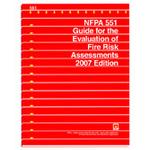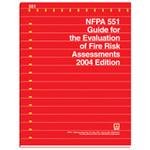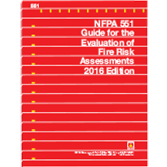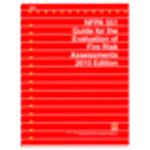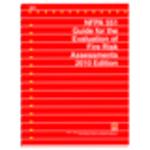NFPA (Fire) 551
Click here to purchase
Use NFPA 551 to approve or evaluate fire and life safety solutions based on fire risk assessments.
The application of fire risk assessment methods in developing fire and life safety solutions continues to increase. NFPA 551 identifies various types of fire risk assessment methods and describes the properties these methods should possess.
The Guide addresses:
- Applying risk informed decision-making for fire safety
- Selecting fire scenarios, identifying representative challenging scenarios and grouping such scenarios into clusters for the purposes of conducting more effective consequence analysis
- Documentation that should accompany a fire risk assessment
- Capabilities of those conducting a fire risk assessment
Revised with up-to-date terms concerning performance-based design and fire risk assessment methods, this 2007 edition adds:
- Guidance on how to address uncertainty when conducting a fire risk assessment
- Factors to consider when conducting or reviewing a fire risk assessment
- Guidance on how to address the changing effectiveness of fire protection equipment, features, programs, and procedures
- Expanded discussion on the role of qualitative, semi-quantitative likelihood, semi-quantitative consequence, and quantitative methods in a fire risk assessment
- Expanded discussion on cost benefit analysis
- More detail on proper documentation and elements of a fire risk assessment
- Expanded guidance on applying risk informed decision making for various fire safety goals including the preservation of cultural resources
NFPA 551 also covers the purpose and importance of an operations and maintenance manual in conducting a fire risk assessment, and the importance of using checklists that address both likelihood and consequence.
Product Details
- Published:
- 04/15/2007
- Number of Pages:
- 24
NFPA (Fire) 551
Click here to purchase
New guidance on fire risk assessment methods.
The application of fire risk assessment methods in developing fire and life safety solutions continues to increase. NFPA 551 is a brand new document that identifies various types of fire risk assessment methods and describes the properties these methods should possess. It provides guidance that was previously unavailable to those responsible for approving or evaluating fire and life safety solutions based on a fire risk assessment. In addition, the Guide serves as an important resource to those who conduct these assessments.
Product Details
- Published:
- 09/15/2004
- Number of Pages:
- 20
- Product Code(s):
- 55104
NFPA (Fire) 551
Click here to purchase
NFPA 551 helps users evaluate the appropriateness and execution of a fire risk assessment for a fire safety problem.
Professionals who review or conduct fire risk assessments — AHJs, insurance professionals, and building owners — rely on NFPA 551, Guide for the Evaluation of Fire Risk Assessments to spell out the various types of fire risk assessment methods and describe the properties these methods should possess.
Understand the basis for fire assessments and learn how to confidently:
- Apply risk-informed decision making for fire safety
- Select fire scenarios, identify representative challenging scenarios, and group such scenarios into clusters for the purposes of conducting more effective consequence analysis
- Develop appropriate documentation to accompany a fire risk assessment
- Evaluate qualifications of those conducting a fire risk assessment
Comprehensive coverage includes:
- Guidance on how to address uncertainty when conducting a fire risk assessment
- Factors to consider when conducting or reviewing a fire risk assessment
- Guidance on how to address the changing effectiveness of fire protection equipment, features, programs, and procedures
- Discussion on the role of qualitative, semiquantitative likelihood, semiquantitative consequence, and quantitative methods in a fire risk assessment
- Discussion on cost-benefit analysis
- Details about proper documentation and elements of a fire risk assessment
- Guidance on applying risk-informed decision making for various fire safety goals including the preservation of heritage resources
- Updated Annex B, with explanatory material and references to additional guidance in other documents
NFPA 551 also covers the purpose and importance of using an operations and maintenance manual in conducting a fire risk assessment, and the importance of using checklists that address both likelihood and consequence. (Softbound, 36 pp., 2019)
Product Details
- Published:
- 04/04/2018
- Number of Pages:
- 35
NFPA (Fire) 551
Click here to purchase
Correctly evaluate the appropriateness and execution of a fire risk assessment for a fire safety problem with guidance in NFPA 551.
Developed for AHJs, insurance professionals, building owners, and anyone who reviews or conducts fire risk assessments, NFPA 551: Guide for the Evaluation of Fire Risk Assessments identifies the various types of fire risk assessment methods and describes the properties these methods should possess.
NFPA 551 helps AHJs and others understand the basis for fire assessments and learn how to confidently:
- Apply risk-informed decision making for fire safety
- Select fire scenarios, identify representative challenging scenarios, and group such scenarios into clusters for the purposes of conducting more effective consequence analysis
- Develop appropriate documentation to accompany a fire risk assessment
- Evaluate qualifications of those conducting a fire risk assessment
Comprehensive coverage in the 2016 edition includes:
- Guidance on how to address uncertainty when conducting a fire risk assessment
- Factors to consider when conducting or reviewing a fire risk assessment
- Guidance on how to address the changing effectiveness of fire protection equipment, features, programs, and procedures
- Discussion on the role of qualitative, semi-quantitative likelihood, semi-quantitative consequence, and quantitative methods in a fire risk assessment
- Discussion on cost-benefit analysis
- Details about proper documentation and elements of a fire risk assessment
- Guidance on applying risk-informed decision making for various fire safety goals including the preservation of heritage resources
Product Details
- Published:
- 03/05/2015
- ISBN(s):
- 9781455911356
- Number of Pages:
- 35
NFPA (Fire) 551
Click here to purchase
Assess the appropriateness and execution of a fire risk assessment for a given fire safety problem with the 2013 NFPA 551.
The application of fire risk assessment methods in developing fire and life safety solutions continues to increase. NFPA 551: Guide for the Evaluation of Fire Risk Assessments identifies various types of fire risk assessment methods and describes the properties these methods should possess. While the primary audience is anticipated to be authorities having jurisdiction, the Guide, will also be useful for others who review fire risk assessments, such as insurance company representatives and building owners.
NFPA 551 helps users:
- Apply risk informed decision-making for fire safety
- Select fire scenarios, identify representative challenging scenarios, and group such scenarios into clusters for the purposes of conducting more effective consequence analysis
- Develop appropriate documentation to accompany a fire risk assessment
- Evaluate capabilities of those conducting a fire risk assessment
Comprehensive coverage includes:
- Guidance on how to address uncertainty when conducting a fire risk assessment
- Factors to consider when conducting or reviewing a fire risk assessment
- Guidance on how to address the changing effectiveness of fire protection equipment, features, programs, and procedures
- Discussion on the role of qualitative, semi-quantitative likelihood, semi-quantitative consequence, and quantitative methods in a fire risk assessment
- Discussion on cost-benefit analysis
- Details about proper documentation and elements of a fire risk assessment
- Guidance on applying risk informed decision making for various fire safety goals including the preservation of cultural resources
NFPA 551 also covers the purpose and importance of an operations and maintenance manual in conducting a fire risk assessment, and the importance of using checklists that address both likelihood and consequence.
Product Details
- Published:
- 12/17/2012
- ISBN(s):
- 9781455905966
- Number of Pages:
- 35
NFPA (Fire) 551
Click here to purchase
The application of fire risk assessment methods in developing fire and life safety solutions continues to increase. NFPA 551: Guide for the Evaluation of Fire Risk Assessments identifies various types of fire risk assessment methods and describes the properties these methods should possess.
The 2010 NFPA 551 helps users:
* Apply risk informed decision-making for fire safety
* Select fire scenarios, identify representative challenging scenarios and group such scenarios into clusters for the purposes of conducting more effective consequence analysis
* Develop appropriate documentation to accompany a fire risk assessment
* Evaluate capabilities of those conducting a fire risk assessment
Now with up-to-date terminology for evaluating fire risk assessment methods, NFPA 551 includes:
* Reorganized Chapter 7 to address documentation requirements
* Guidance on how to address uncertainty when conducting a fire risk assessment
* Factors to consider when conducting or reviewing a fire risk assessment
* Guidance on how to address the changing effectiveness of fire protection equipment, features, programs, and procedures
* New discussion on the role of qualitative, semi-quantitative likelihood, semi-quantitative consequence, and quantitative methods in a fire risk assessment
* New discussion on cost-benefit analysis
* Details about proper documentation and elements of a fire risk assessment
* Guidance on applying risk informed decision making for various fire safety goals including the preservation of cultural resources
NFPA 551 also covers the purpose and importance of an operations and maintenance manual in conducting a fire risk assessment, and the importance of using checklists that address both likelihood and consequence.
Product Details
- Published:
- 12/05/2009
- ISBN(s):
- 9780877659365
- Number of Pages:
- 33
You May Also Like
